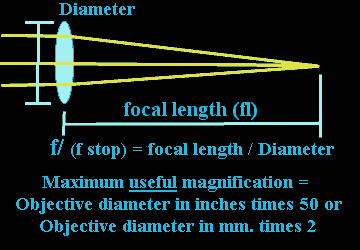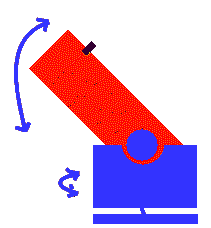

 |
 |
| Understanding Telescopes |
Astronomy through out history was done with the eyes and various instruments to measure the visible stars and planets position in the sky. The invention of the first telescope was a refractor by Galileo Galilei in 1609 opened astronomy to many new discoveries. As the optics of the telescopes improved, and we were able to see clearly deeper and deeper into space, our knowledge of space also deepened. Now we have telescopes and other instruments that can see in most every energy frequency there is. This allows us to see deep into the hearts of galaxies and nebulas.
The telescopes main purpose is to gather light and concentrate it to our eyes. Our eyes, at their best, collect light through a hole that is about 7 millimeters in diameter. This allows us to see only the brightest objects. This is perfect for seeing on our planet during the day. A small telescope 60 millimeters in diameter (about 2.5 inches) collects hundreds of times more light than what your eye does. This light, once concentrated, can be magnified and sent to your eye. There are several designs for telescopes. They all have their strengths and weaknesses. The one that is right for you will be determined on your needs and budget. This section should help you to be able to make an intelligent decision on a telescope.
A refractor telescope is one where light, as it passes through the lens, is bent. This light is bent toward a focal point near the eyepiece. Here the bright concentrated image can be magnified up to the limits of the objective lens.
A reflector telescope uses a mirror in place of the objective lens. The mirror is shaped and polished in such a way that when light is reflected off the surface it is brought to a focal point like the lens. The concentrated light is then magnified and brought to your eyes by the eyepiece.
Now we will get an understanding of magnification or power with a telescope. When you see that nice 2.4 inch refractor telescope at the department store with ads displaying 500X power and showing a big picture of the planet Saturn, you are being mislead. That does not mean all telescopes sold in department stores are necessarily bad telescopes, but it does mean BE AWARE. You will not be able to see a big Saturn with all kinds of detail, you will see just a small ball with a ring around it and some detail. There are two basic things about all telescopes you should know. How to know the maximum useful magnification of a telescope and how to get different magnification out of a telescope.

The maximum useful magnification of a telescope is how much magnification or power a given telescope can give before the image is useless. When the objective of a telescope forms an image the eyepiece magnifies part of that image and sends it to your eye. The larger the objective is the more the image can be magnified before the image breaks down to blurred blobs. After that the image just gets fuzzier and dimmer the higher you go. To figure out how high you can go before image breakdown, you just multiply the diameter of the objective in inches by 50 or multiply the diameter of the objective in millimeters by 2
With this knowledge we can see that a 2.4 inch objective lens in that department store telescope times 50 gives a maximum power of 120X, anything more would be useless.
Now how can they advertise 500X telescope, are they lying? The answer is no, they supply all the eyepieces and accessories to get to the advertised magnification. To find the magnification of a telescope you need to know the focal length of the objective (given with the specification sheet) in millimeters and the focal length of the eyepiece (imprinted on the eyepiece) in millimeters. Now divide the focal length of the eyepiece by the focal length of the eyepiece. Going back to that department store telescope. Lets say the objectives focal length is 900 millimeters and one of the eyepieces focal length is 4.5 millimeters. 900 divided by 4.5 gives us 200X power. That is over the useful magnification but short of the advertised power. If they supplied a 2.5X Barlow lens then you could multiply 200X of blur by 2.5 and get 500X of very dim blurryer blur as advertised. The nice large picture of Saturn is just that, a nice picture taken with a very nice, large, expensive telescope, and the photo is enlarged..
As I said before not all department store telescopes are bad telescopes. You need to check with your local astronomy club or reviews in telescope magazines on the web.
Telescopes usually come with some kind of a mount, from a simple table tripod to complex, computer driven equatorial mounts. The main purpose of a mount is to provide stability for the telescope. Due to the telescopes magnification the view through a telescope covers a very small area and as that area is magnified any wiggle or jiggle of the telescope is magnified. A mount must be steady enough to not allow a slight breeze ruin your viewing and be steady enough to quickly settle down as you focus or nudge the telescope.

There are two basic types of mounts. The simplest is the Alt-Azimuth Mount. This mount allows you to move your telescope in a circle even with your horizon. It also allows you to tilt your telescope up and down. This mount is basically found on tripods but is also used on Dobsonian mounts. A Dobsonian is basically a box that swivels around, with the telescope attached kind of like a cannon allowing it to tilt up and down. With the tripod you can easily adjust most of them to a height that is comfortable for your viewing, but are prone to being shaky. While the Dobsonian is very steady it is not at all adjustable and can be a challenge to look through at times if you are short.

The other type of mount is an Equatorial Mount. This mount is tilted in such a way that it swivels even with the Earth's plane of rotation, while also allowing the telescope to tilt up and down. This arrangement takes more work to properly setup and align the mount with the Earth, but pays off in finding and tracking stellar objects. You can view objects for longer periods of time with less distractions especially if you have a clock drive that allows you to track an object automatically. There are two basic types of Equatorial Mounts one is a German Equatorial Mount and the other is a Fork Mount. A Fork Equatorial Mount is best used where you have a short telescope, if used on a large scope they are much larger and have to be permanently mounted as they are heavy. The German Equatorial Mount gets lighter than an equal size Fork Mount as soon as you go to scope sizes 6 inches diameter and larger, but Fork mounts are easier to set up.